Atlas Obscura’s Guide to Communist Mummies
.jpg)
“It is easy to be a saint if you have no wish to be human.” - Karl Marx
While these dictators and despots held unquestioned power in their lifetimes, they wielded no such control in death. Despite requesting to be buried or cremated, their comrades had other plans and they were turned into mummified waxy icons - each a human-corpse embodiment of the country they once ruled.
Joining the ranks of these communist-god-relics is the the supreme leader of North Korea Kim Jong-il. Even atheist ideologies need their incorruptible saints, and sometimes belief in a leader is so strong, even death can’t loosen their iron grip. As they say in Kim Jong-il’s anthem ”No Motherland Without You”, a song taught to every North Korean
Even if the world changes hundreds of times. People believe in you, Comrade Kim Jong-il
We cannot live without you. Our country cannot exist without you!
So what to do when your supreme leader, without whom your country cannot exist, dies? You had better keep him around. The song doesn’t specify that he needs to be alive.
Kim Jong-Il - Pyongyang, North Korea
Shortly after Kim Jong-il’s death was announced on December 17th, 2011 it was looking shaky as to if Kim Jong-il would be joining the elite ranks of communist mummies. (Only ten communist leaders have previously been successfully mummified, less than the number of people who have walked on the moon.) Originally the reports out of North Korea said that Kim Jong-il would be buried and not given the “full Lenin” like his father Kim Il-sung had. One reason for this is that it is quite expensive. North Korea is rumored to have paid Russian embalmers at least a million dollars for the preservation of Kim Il-sung. Of course, despite the poverty throughout North Korea, what is money to a state with absolute power?
On December 17, 2012, one year after his death, Kim Jong-il’s mummified body was revealed, still clad in his legendary jumpsuit. Along with his mummified body, some items from Kim Jong-il’s life are on display including his armored train carriage, yacht, parka, sunglasses, and his pointy platform shoes which he wore in the later years of his life. In a recreation of his work desk a macbook pro sits open, ready to send the emails of the Supreme Leader.
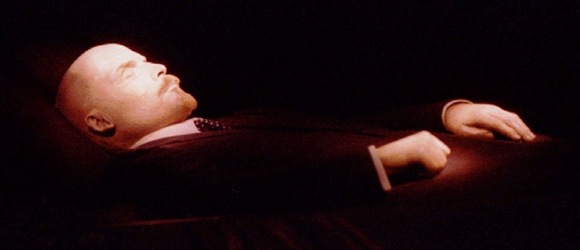
Vladimir Ilych Lenin - Moscow, Russia
Situated at the edge of Moscow’s Red Square is a pyramid made of polished red and black stones that marks the resting place of one Vladimir Ilych Lenin. The pate-headed leader of the Bolshevik revolution was of course an atheist, so had intention of going anywhere after death but the grave, however he did formally request to be interred. His comrades would hear of no such thing. The Russian government allegedly received over 10,000 telegrams from the grieving public asking for the body of great leader to be preserved in some way for the generations to come.
Instead, it was decided that Lenin’s body would be embalmed and put on display in a glass sarcophagus within a mausoleum. Lenin’s corpse has been there since, with only one brief exception – a vacation, if you will, to Tymen, Siberia (along with his embalmers, who worked to keep him “fresh”),when Moscow was under the threat of Nazi invasion. In March of 1945, a Soviet operation codenamed “Object No. 1” moved Lenin’s body from Siberia back to the Moscow mausoleum.
Though Lenin was one of histories most powerful figures, even he cannot withstand the ravages of time without a little help. The task of embalming Lenin was originally “undertaken” by a team of Jewish embalmers named Vladimir Vorobiev and Boris Zbarsky who developed secret techniques to help preserve the body.
To this day a team of embalmers buffs his waxy skin, bathes his body, bleaches him, and changes his smart silk suits (yes, really) at regular intervals. Though recently Lenin was forced to cut-back on his sartorial habits due to the Great Recession and had to wear the same suit for nearly six years in a row. Tours are available daily, though cameras are forbidden. Taking his photo may steal his soul, after all. (image source)
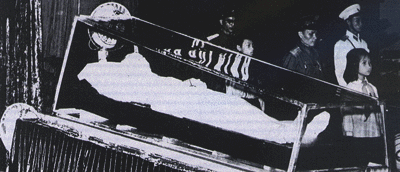
Ho Chi Minh - Hanoi, Vietnam
Similar to Lenin, the leader of the Democratic Republic of Vietnam’s burial wishes went the way of the U.S.S.R. Despite having explicitly stated his desire to be cremated, the Ho Chi Minh Mausoleum contains a glass casket displaying Uncle Ho’s dead body for a steady stream of passers-by to admire.
In fact, Uncle Ho looks good enough that he’s sparked some controversy. Popular consensus holds that even a perfectly embalmed body would have shown more signs of decay than that of Vietnam’s revered leader. Shortly after the 40th anniversary of his death, the mausoleum was closed “for renovation” during which period, a team of Russian experts (whose knowledge was honed by caring for Lenin’s delicate, dead visage) contributed their two-cents as to the best means of continued preservation. Despite all this, those who have routinely payed homage to Ho Chi Minh’s body have begun to express doubts, citing that he just no longer appears believable.
It would seem the best verdict is the one reached by ones own eyes. For $2 USD, visitors can form their own opinions, albeit quickly as stopping before glass casket is prohibited. (image source)
.png)
Chairman Mao Zedong - Beijing, China
As architect and mastermind of the People’s Republic of China, “Chairman” Mao Zedong developed such a cult-like following that one would think such a figure’s wishes would have been respected after his death. Sadly for Mao, this was hardly the case. Despite being one of the first people to sign the “Proposal that All Cultural Leaders be Cremated After Death” in 1956, Mao’s body was placed on display in the Great Hall of the People while a memorial was held in Tiananmen Square.
Afterward, his embalmed figure was placed in the Mausoleum of Mao Zedong, erected in the six month time span immediately following his death. Displaying Mao was one of the more difficult challenges faced by the authorities. A crystal coffin was a necessity, but the manufacturing technique for such a piece had been a closely guarded secrets held by the Soviet Russians, then political enemies of China. A competition to build Mao’s crystal casket was held on the down-low, and each competitor was forced to place its entry through a series of environmental stress tests, including earthquake-proofing.
Though the coffin was up to snuff, the embalming was not. In death his ears stuck out at funny angles, his body swelled, and the embalmers were forced to cut his suit just to keep him from bursting out of it. One of Lenin’s embalmers was recently quoted about Mao Zedong saying “I hear the body’s in terrible shape…they did very bad work.”
Mao’s remains continue to be a popular tourist attraction to this day. Only the Chairman’s immediate family members are allowed private visitation, though average Joes are permitted to quickly file past the mummy of Mao.
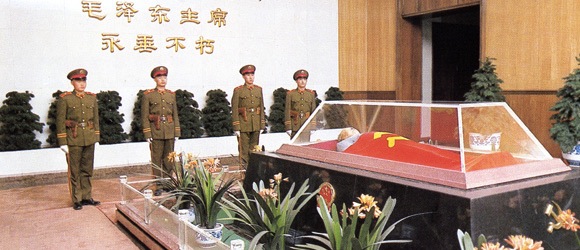
Kim Il Sung - Pyongyang, North Korea
The unconditional love with which the vast majority if North Koreans worship Kim Il Sung is evident nowhere more than at the home of his embalmed body. Displayed in the Kumsusan Memorial Palace on the edge of Pyongyang, the Great Leader and Eternal President makes his eternal resting place in what is described as one of the nation’s largest “megalomaniac Communist-fascist” buildings.
A foreign, first-hand witness describes the process of paying respects to Kim Il Sung on the anniversary of his birthday as one of the more surreal experiences of his life. It consisted of a half-day parade of pomp and circumstance including a full tour of the mausoleum, forceful usage of a wind tunnel and rubber rollers against the soles of their shoes to remove all filth from visitors, never ending Kafkan hallways pulsating to the tunes of mournful Socialist Realism music, and more.
That said, as with many specific details pertaining to North Korea, there’s a bit of debate as to how the rest of us can actually see the Great Leader’s body up close. The Kumsusan Palace’s Wikipedia page states that official government tours are led on Thursdays and Sundays, though conflicting travel guide evidence suggests that actually viewing Kim Il Sung requires special arrangements made very far in advance. (image source)
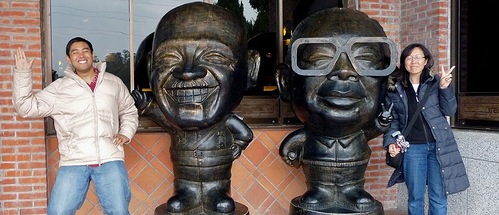
Chiang Kai-shek and Chiang Ching-kuo - Cihu, Taiwan
Both the former President of Taiwan and his son, Chiang Ching-kuo, remain embalmed in an earthy purgatory while familial and political forces hash it out to determine their ultimate resting places. In order to understand the conflict of interest, a small history lesson may be necessary:
Before General Mao, there was Chiang Kai-shek. As leader of China’s Nationalist Party, Chiang spent much of his life embroiled in civil wars against the Communist political movement lead by Mao Zedong. His portrait once even occupied the space now given to Mao’s in today’s Red Square. As World War II drew to a close, internal and external pressures caused tensions to come to a head between the two figureheads. Ultimately Mao lay siege on all of Chiang’s territory in a push that resembled a very gutsy move in t game of Risk.
Chiang lost control of mainland China and was relegated to Taiwan where he sat as President, plotting the how he would retake mainland China all the way up until his death in 1978. After an interim period, Chiang’s son Chiang Ching-kuo assumed control as well as his father’s Nationalist mantle and mission until his own death in 1988.
To this day, both Chiangs’ bodies remain uninterred. The family argues that their will should be fulfilled, in which they both requested to be buried in their home of Fenghua on the mainland. Obviously because the area remains under Chinese Communist control, this isn’t going to happen anytime soon. The makeshift solution has been to embalm both men and place them on display in Cihu, Taiwan until a burial compromise is reached… which could literally be an eternity. (image source)

Stalin - Moscow, Russia
From 1922 until his death, Joseph Stalin held the title of first General Secretary of the Communist Party of the Soviet Union’s Central Committee. After Lenin passed, Stalin slowly but surely accumulated nearly all of the USSR’s power into his own hands and was the primary architect of the Eastern Bloc as it appeared throughout much of the Twentieth Century.
Seen now as one of the worst dictators in history, in his personal life Stalin lived like he meant it; a heavy smoker and drinker, most historians and specialists agree that vice-induced atherosclerosis led to a series of debilitating – and ultimately fatal –strokes. Others claim that Stalin was assassinated by means of warfarin, an odorless and tasteless poison that causes strokes.
Regardless of the cause, Stalin’s dead body was embalmed and placed along side Lenin’s mummy immediately after his death in 1953. Mourners could gaze up on both of the Republic’s founding fathers in conjunction until Halloween of 1961 when Stalin (sort of) rose from the dead. Officials had him buried next to the Kremlin as part of the process of de-Stalinization. Lenin has been lonely ever since. (image source)

Georgi Dimitrov - Sofia, Bulgaria
The circumstances that brought about the 1949 death of Georgi Dimitrov, Communist leader of Bulgaria, are simply dodgy. Dimitrov had been in excellent health up until the time of his death at a sanitarium just outside Moscow, leading to persistent (yet unverifiable) rumors that he was either irradiated or fatally poisoned. Despite this question death, his body was promptly put on display in his very own mausoleum on Prince Alexander of Battenberg Square in downtown Sofia.
In record fashion, it took only six days for the Georgi Dimitrov Mausoleum to go from conception to erection. During this time, Dimitrov’s body was shipped home from the USSR to be placed into his honorable resting place, and the proletariat began their mourning while lauding their country’s engineering prowess, a double-whammy in the political morale boosting category.
Everything continued to go as planned until the fall of the Berlin Wall. Bulgaria’s new leaders deemed it unseemly to continue honoring their Communist predecessors in this manner, so they condemned Dimitrov’s Mausoleum and buried his body in Sofia’s Central Cemetery where visitors can pay homage today. Heated debate followed their decision, delaying the demolition until 1999, at which point Dimitrov’s body was finally cremated then buried again. But Dimitrov had a final chuckle. It took a whopping four tries – three separate single-blast explosions followed by the successful combination of smaller detonations and bulldozers – to level his mausoleum, a building built in six days. Apparently Bulgarian engineering deserved the praise. (image source)
Klement Gottwald - Prague, The Czech Republic
Like Stalin, Klement Gottwald lived, and died, hard. Only five days after attending Stalin’s funeral, Gottwald met his end thanks to a burst artery caused jointly by the effects of severe syphilis and years of alcoholism. Despite such an unbecoming finale, his constituents from the Czech Republic insisted upon the leader of Socialist Czechoslovakia being embalmed for the ages.
Originally the plan had been that Klement Gottwald’s embalmed body would remain on display in a mausoleum on the grounds of Prague’s Jan Zizka Monument. City infrastructure was reworked and a massive environmental control unit was placed within the preexisting monument. Everything was hunky-dory for a bit… until it became apparent that something had gone terribly wrong in the process of preserving Gottwald’s body.
Basically, the formula used in the preservation process was a botched batch, resulting in the need to re-embalm his entire body every 18 months. This was standard procedure until the early 1960’s, when Gottwald started leaking formaldehyde while appearing a stomach-churning black color. “Progressive putrefaction” as it were.
His successors realized the indignity of subjecting their former leader to such a fate, and finally had him cremated in 1962. Interested parties can still pay homage at the site of his former mausoleum at the Zizka Monument, a behemoth visible from nearly anywhere in the Czech capital. (image source)
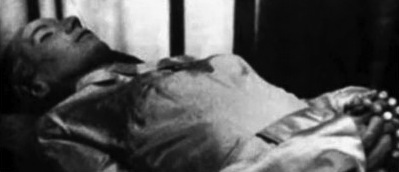
Eva Peron - Buenos Aires, Argentina
Editors Note: Yeah yeah, we already know. Peronism isn’t quite Communism and therefore shouldn’t *technically* appear on this list. We hear you. But Peronism was close enough for us: a form of authoritarian populism, it relied heavily on labor, was anti-religion, and had a strong centralized government. Besides, this list is in dire need of a woman and the story of her mummy is really awesome.
When the First Lady of Argentina and famed wife of Juan Perón (thank you Andrew Lloyd Webber and Maddona) passed away from cancer on the night of July 26, 1952 her corpse was meticulously prepared by a man renowned for his deft skills in the “art of death.” For two years after, her body was displayed in Juan Perón’s home, appearing to be enjoying a deep and restful sleep while final resting arrangements were being made.
These plans were cut short by a military coup that deposed Juan Perón and sent him into exile. On his way out of the country, arrangements for Evita somehow slipped through the cracks.
For nearly twenty years, until 1971, the whereabouts of her incorruptible body remained a mystery. When the Argentine government finally made it known that Evita had been entombed in a crypt in Milan under a fake name, Evita was exhumed and flown to the residence of Juan Perón in Spain, where he and his third wife Isabel displayed her embalmed body on their dining room table.
In the meantime, Perón had rejuvenated his political potential, which culminated in him regaining power in 1973. He and Isabel returned to Argentina as leaders, though Juan would die in office shortly thereafter. Ultimately it was Juan’s other wife Isabel that Evita could thank for finding a final home for her dead body.
Isabel had Evita buried in the Duarte family plot in Buenos Aires’ expansive La Recoleta cemetery, where curious onlookers can honor one of the most well-traveled corpses in the history of “communist” mummies. (image source)
***
Editors note: What do Communist Dictators. Egyptian Princes, and Italian Saints all have in common? They all love their mummies and deadies. I’ll be here all week, folks.












Follow us on Twitter to get the latest on the world's hidden wonders.
Like us on Facebook to get the latest on the world's hidden wonders.
Follow us on Twitter Like us on Facebook